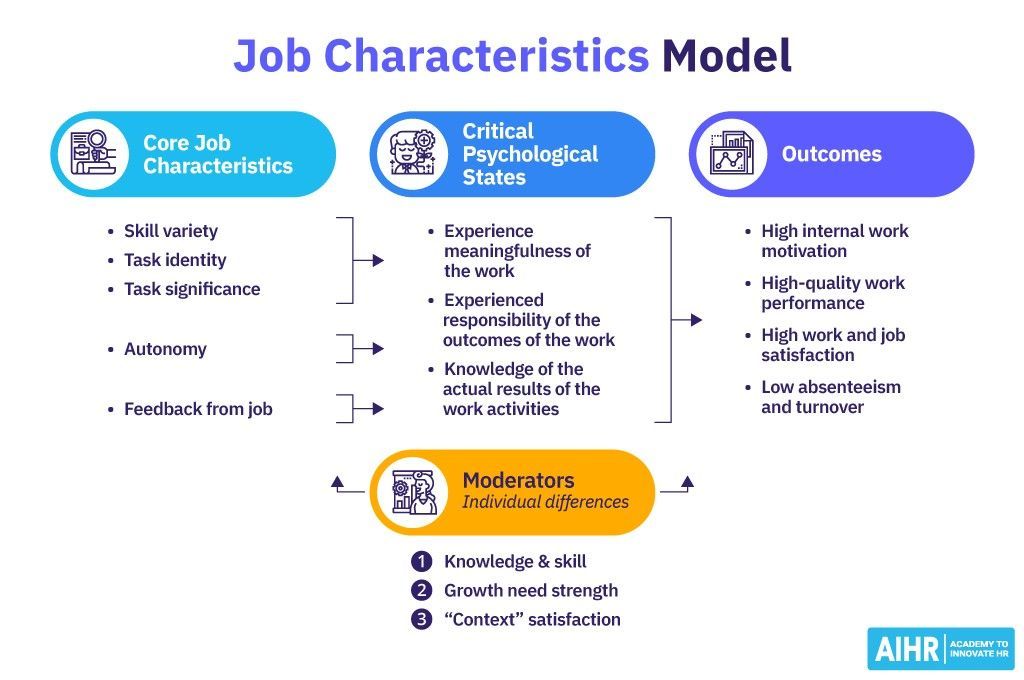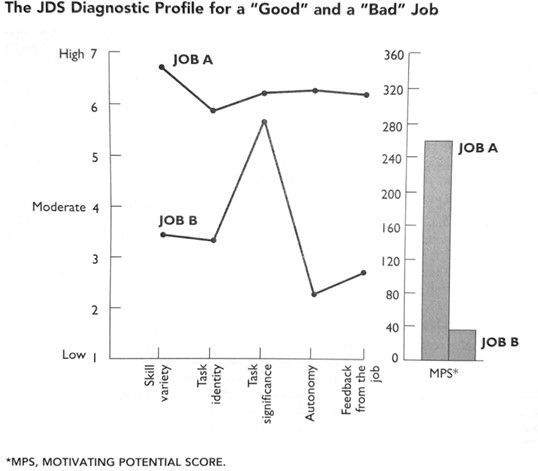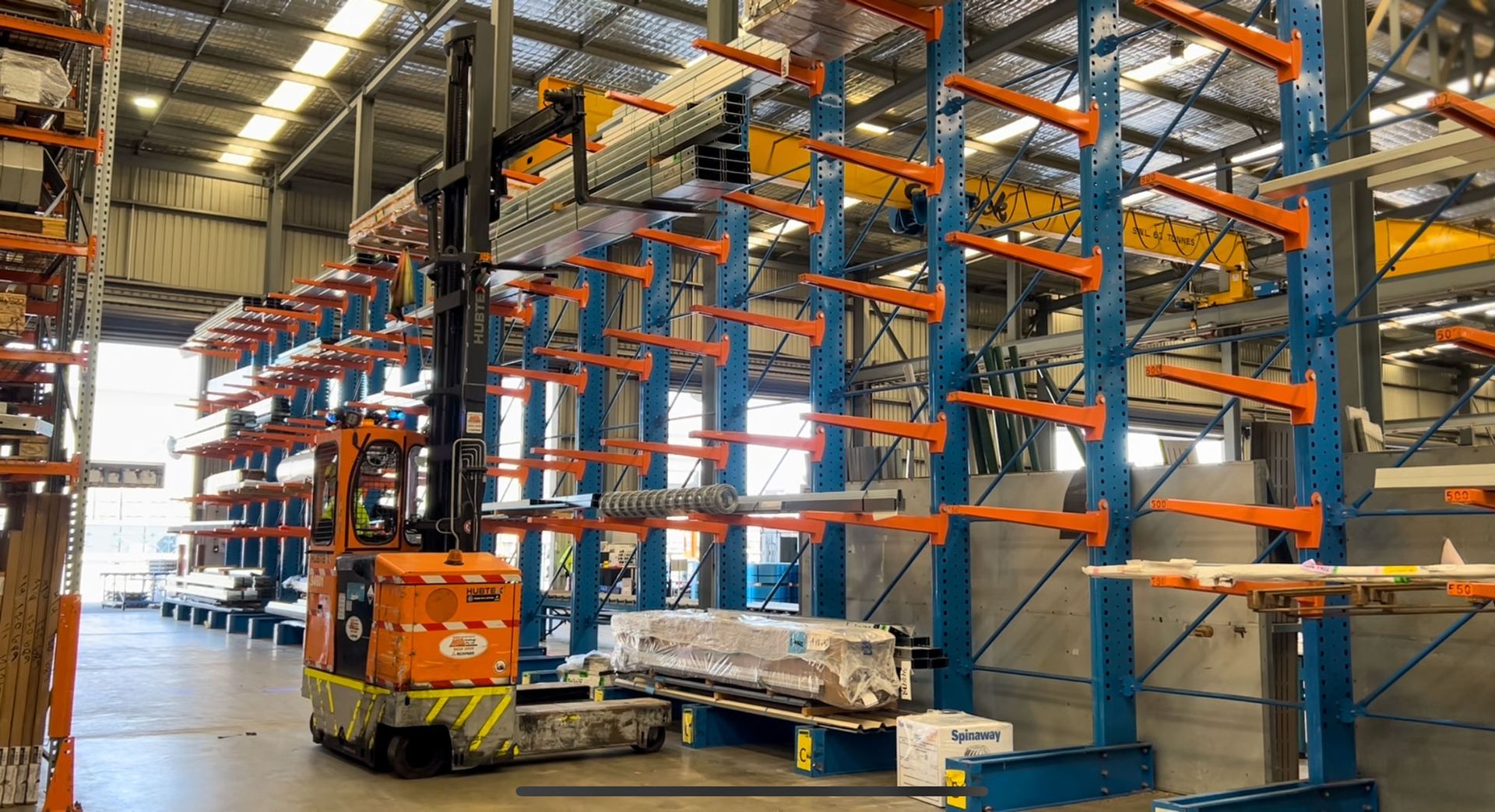Employee Retention Strategies | How to Keep Good Employees
A 1976 Blueprint for Improved Retention
In 1975, organisational psychologists Greg Oldham and Richard Hackman studied 658 workers in 62 jobs across seven organisations, publishing the Job Characteristics Model (JCM) in the following year. 50 years later, this groundbreaking model remains a blueprint for many organisations.
What really sets it apart from others is the ease of implementing and applying the model in a wide range of workplace settings. When implemented and managed, most operations realise significant improvement in employee engagement, the number one driver and predictor of retention.
The Job Characteristics Model Explained
The Hackman and Oldham Model encourages managers to provide meaningful tasks to their employees. It works by categorising factors that guide motivation and productivity in the workplace.
The Job Characteristics Model considers job-related factors that can be changed to increase the positive work behaviours and outcomes (such as higher performance, less absenteeism, and improved employee productivity). It doesn’t look at how relationships and other interpersonal aspects of work affect job satisfaction and performance. However, the pathway to behavioural outcomes is significantly enhanced and, in many cases, almost seamless. So, if you’re seeking behavioural change across a workplace such as building a stronger team culture, applying the JCM would support and lead to better teamwork.
Enhancing employee job satisfaction is a key outcome of applying the JCM principles, especially in light of the 'Great Resignation' which underscores the importance of making employment more rewarding and fulfilling.
The five core job characteristics identified in Oldham and Hackman’s model are:
- Skills variety: Do tasks vary, and are they challenging? Or are they monotonous and too easy?
- Task identity: Do tasks have a defined beginning, middle and end? Without this, it’s hard to achieve the satisfaction of an attained goal.
- Task significance: Does the employee feel that their role and what they are producing has meaning?
- Task autonomy: Do employees have a high degree of independence as they carry out their work?
- Job feedback: Are employees receiving feedback on their performance?
If a job is consciously created to be varied and meaningful, with plenty of two-way communication, employees will naturally be more engaged with their role. According to Hackman and Oldham, they will also have an increased sense of responsibility for their work outcomes.
The five characteristics can easily be used as a checklist for job creation or job review. For example, during the job design stage, employers can ask whether there were multiple key tasks to break the monotony of the role, or whether the job was clearly placed in a wider context so that its relevance was understood.
Motivation
The JCM suggests jobs that are high in the five core characteristics can lead to increased intrinsic motivation, meaning employees are motivated by the inherent satisfaction of the work itself rather than external rewards. See Edward Deci & Richard Ryan, on ‘extrinsic’ (controlled) and ‘intrinsic’ (autonomous) motivation.
Here’s how intrinsic motivation works in a practical sense. Suppose you wanted lots of butterflies in your garden, you could go out and catch them with a net, or you could just create a garden that naturally attracts them. That’s intrinsic motivation, the thing that you want your employees to feel.
Two well applied intrinsic motivational practices that have developed from the JCM are job rotation and job enrichment. Incorporating professional development and promoting a healthy work-life balance are also crucial in creating jobs that are not only satisfying but also motivating, as they cater to the employees' need for growth, well-being, and a sense of balance between their professional and personal lives.
Job Rotation
Job rotations are a program that can be implemented to move employees temporarily or permanently, through different roles within an organisation. Job rotations are typically a lateral move where employees are moved to a role equal to their previous role with the intention of them developing a wider range of skills and expertise. This strategy not only aims to multi-skill your workforce but also to encourage employees to develop a wider range of skills and expertise, fostering a more versatile and engaged team. Job rotations can be sporadic in nature and length, or they can be implemented in line with a structured training and skills development program.
Job Enrichment and Employee Job Satisfaction
Job enrichment introduces engaging elements to the role, building employee intrinsic motivation and of course, reducing the endless cycle of employee departures. Utilising employee feedback is crucial in tailoring job enrichment efforts more effectively, as it plays a significant role in identifying opportunities for enriching jobs and enhancing employee experience, engagement, and retention.
Employee recognition also plays a vital role in fostering motivation and retention by acknowledging individual and team contributions, which strengthens interpersonal relationships and supports a positive workplace culture. This approach ensures that strategic decisions are informed by continuous listening, positively impacting organisational culture and employee satisfaction.
This motivational approach emerged because of the Ford Motor Company’s production line, which left employees bored out of their minds (they were highly productive though). To address this issue, another famous psychologist, Frederick Herzberg published his two-factor theory on motivation. One of his findings proposed that jobs are created to satisfy an employee's needs, in other words, to create intrinsic motivation. To do this, Hertzberg suggested employees should be provided with autonomy, responsibility, the ability to do a job from start to finish, and performance feedback.
There are many different ways to enrich a job. Here are some good starting questions to assess where you might start. Ask yourself….
- Are there tasks that can be combined to give variety?
- Are there tasks that can be separated and divided among employees to increase variety?
- Is a siloed function working, or would it increase variety, autonomy, and task significance if you had more employees responsible for more tasks that produce the final product or outcome?
- Is there an opportunity for growth? Are the skills the employee develops with their job applicable to higher-skill positions? If not, what tasks can you add to increase these skills?
- Are you providing regular feedback that enables employees to grow and improve? Is natural feedback occurring? Do employees feel like the important work they do fits into the larger picture? Checking in and ‘testing’ how they feel about the bigger picture can improve feedback organically.
The Job Diagnostic Survey
In addition to some of those questions (and answers), it’s equally important to understand the employee’s perspective of a job, in particular, its meaningfulness. Job Diagnostics Surveys can be complicated and time-consuming, so it's usually better to outsource the project to an HR or Management Consultant.
If it’s something you want to embark on yourself, the following steps offer a guide to determining Job Diagnostic Surveys and determining a Motivating Potential Score (MPS).
To calculate the MPS from a Job Diagnostic Survey, you'll need to follow these steps:
- Administer the Survey: Distribute the Job Diagnostic Survey to employees, ensuring that it includes questions related to the five core job dimensions outlined above.
- Score Each Dimension: For each dimension (skill variety, task identity, task significance, autonomy, and feedback), calculate an average score based on the responses to the corresponding survey questions. Use a Likert scale or numerical rating scale to quantify responses.
- Calculate the MPS for Each Employee: Once you have average scores for each dimension, use the following formula to calculate the Motivating Potential Score (MPS) for each employee: MPS = [(Skill Variety + Task Identity + Task Significance) / 3] Autonomy Feedback
- Aggregate the MPS: Calculate the average MPS for all employees to assess the overall motivating potential of jobs within the organisation.
- Interpret the Results: A higher MPS indicates a greater motivating potential of jobs within the organisation. Evaluate the results to identify areas where the organisation excels in providing motivating job characteristics and areas that may require improvement.
- Take Action: Use the findings to implement changes or interventions aimed at enhancing the motivating potential of jobs. This may involve redesigning job roles, providing additional training or resources, or restructuring work processes to increase autonomy and feedback.
Retention Drivers to Retain Employees
Employees stay with the same employer for various reasons. The well-worn saying “it’s them, not me” is hard to eliminate as a factor. But despite how it may feel, a causal analysis is likely to reveal several reasons that have influenced an employee's resignation.
Offering competitive compensation, including competitive pay, a competitive salary, and comprehensive employee benefits, can significantly boost employee retention and reduce the likelihood that employees quit. Providing flexible schedules, wellness programs, and paid parental leave is especially important for supporting working parents and promoting work-life balance. Clear career paths also play a vital role in retaining talent by supporting professional growth and development.
This might sound oversimplified, but many resignations are preventable. The harsh truth is that employers and managers are not only responsible for much of the churn but can influence a great deal more control (than they think) over the seemingly endless cycle of employee departures.
Understanding employee turnover and the reasons why employees leave is crucial for any organisation’s ability to maintain a stable and engaged workforce. Factors such as seeking more attractive opportunities elsewhere, employee burnout, or a lack of good work-life balance can significantly impact an organisation’s performance and morale.
Implementing strategies such as off-boarding processes and conducting exit interviews with each departing employee can help organisations to gain valuable insights to improve retention. Supporting existing employees and integrating new employees effectively through a strong recruitment process and onboarding are also essential. If organisations do not address career development and support needs, they risk losing employees. This not only helps in retaining talent but also in ensuring the organisation’s ability to achieve its mission by maintaining a productive and motivated team.
Introducing a job design model, job rotation or enriching the roles your employees carry out is exactly the sort of control and influence you’re able to exercise. And it’s a relatively straightforward way of improving retention, but also employee engagement, productivity, and efficiency.
An Important Assumption
The group of employees you’re targeting (which should be the majority) are best described as ‘good people’. I define these as being at least proven performers who turn up, complete a satisfactory amount of work and to a reasonable standard - not necessarily your top performers. You certainly don’t want to be retaining people who are not only underperforming but don’t have a baseline, acceptable behaviours, and attitudes. Although a few of those on the fringe could change for the better given a job design update and application of the JCM.
Job Indifference and The Surprise Resignation
Many employees are indifferent about their job, or the manager they report to, or the organisation, or all three. These employees are not actively looking for another job, however, they are open to the idea of leaving if contacted about another role that might sound better. This makes these employees vulnerable to offers, referrals or any other type of new job offer. This is potentially a large group of your employees, and they are often hard to identify or quantify.
It’s very important to have strategies in place that prevent or at least identify the feeling of indifference and the chances of turnover, as these are crucial steps to improve employee retention. A good starting point is to understand which employees perceive their jobs as meaningful, challenging, and rewarding. Employees often cited factors such as recognition and flexible schedules as important contributors to their job satisfaction. The Job Diagnostics Survey is one method of uncovering potential indifference or silent discontent amongst employees.
Creating a Positive Work Environment
Creating a positive work environment is at the heart of any successful employee retention strategy. When employees feel valued, supported, and empowered, they are more likely to stay engaged and committed to the organisation. A positive workplace culture not only boosts employee satisfaction but also encourages career development and fosters a sense of belonging.
To build a positive work environment, organisations should prioritise flexible work arrangements, such as remote work options and flexible hours. These flexible work arrangements help employees achieve a healthy work-life balance, reducing employee burnout and supporting well-being. Encouraging employees to take advantage of professional development and career development opportunities, like training programs, mentorship, and ongoing education, demonstrates a commitment to their growth and career progression.
Recognition programs are another key element. Regularly acknowledging achievements, both big and small, helps employees feel appreciated and motivates them to perform at their best. Encouraging employees to share feedback and suggestions through employee surveys or open forums ensures that all your employees feel heard and involved in shaping the work environment.
By implementing these employee retention strategies, organisations can create a positive work environment where employees feel valued, job satisfaction is high, and employee morale thrives. This not only helps in retaining employees but also drives business performance and long-term success.
Measuring Success
Measuring the success of your employee retention strategies is essential for continuous improvement and ensuring your efforts are making a real impact. Start by tracking key metrics such as employee turnover rate, employee engagement scores, and job satisfaction levels. These indicators provide valuable insights into how well your retention strategies are working and where adjustments may be needed.
Conducting regular employee surveys is a powerful way to gather feedback directly from your workforce. These surveys can uncover trends in employee satisfaction, highlight areas for improvement, and help you understand the reasons behind employee turnover. Analysing data on career progression, such as promotions and internal mobility, can also reveal whether your organisation is effectively supporting career advancement and retaining top talent.
Additionally, reviewing exit interviews and tracking the reasons why employees leave can help you refine your retention strategies and address any recurring issues. Monitoring the impact of your retention strategies on business performance, such as increased productivity, higher customer satisfaction, and revenue growth, demonstrates the return on investment of your efforts.
By regularly assessing and adjusting your retention strategies based on data and employee feedback, you can ensure your organisation is effectively retaining employees, building employee engagement, and driving long-term business success.
The Final Word
Management and Job Design Consultancy is a very big business and it’s extensively written about. Most of the information is at least interesting if not useful, but if I reflect on my 20 years working with, and observing many different operations of all sizes and types, retention really comes down to two vital factors:
- The people, or more specifically, work relationships.
- Engagement with the job and in particular the sense of satisfaction and purpose all of us get (or hopefully get one day).
There are many alternate job design models, some more sophisticated than others, but the critical factor is to decide on how your employees will be the most satisfied, motivated and engaged. And most importantly, (and often the most difficult) invest time in the activity of feedback, progress, skills development, and performance.
A strong company culture that emphasises diversity, inclusion, and fair treatment is fundamental in retaining employees. By focusing on employee satisfaction and engagement, companies can nurture a work environment that employees want to be a part of. Implementing strategies that promote better work-life balance, recognise employee achievements, and provide opportunities for professional development are key in retaining talented workers. Understanding the importance of both hygiene factors and motivating factors, as outlined in Frederick Herzberg's Two-Factor Theory, can significantly enhance employee satisfaction and retention. These efforts collectively contribute to a positive work atmosphere that supports long-term retention and reduces turnover.
Designing jobs to incorporate the five core characteristics of the JCM can have a significant impact on employee retention. Well implemented and managed, it enhances job satisfaction, intrinsic motivation, engagement, commitment, and reduces turnover intentions or job indifference. Businesses and operations that apply the principles of the JCM to job design are more likely to create a work environment that promotes long-term retention of good employees.
Need Help with Staff Retention or Recruitment?
Maintaining a motivated and stable workforce is crucial but challenging. If you're facing high employee turnover, struggling with employee burnout, or need to refine your retention strategies, we're here to assist.
Reach out for a no-obligation discussion to explore how our tailored solutions can enhance your employee engagement and employee experience. Whether you need to revamp your onboarding process, develop recognition programs, or implement effective retention strategies to reduce employee turnover, our experts are ready to help.
Contact us today and let's create a thriving work environment that supports your company's goals and values.
Meet our Recruitment Specialists here.
Join Our Mailing List
Interested in receiving the latest industry news, HR & safety advice, and recruitment and retention tips straight to your inbox each month?
Sign up to our mailing list below!














